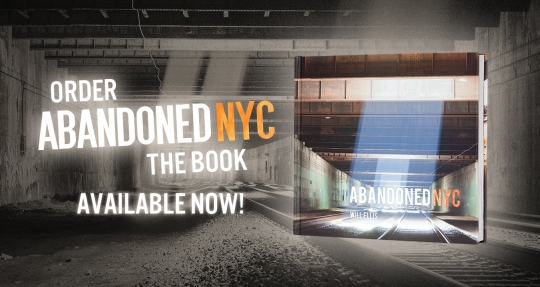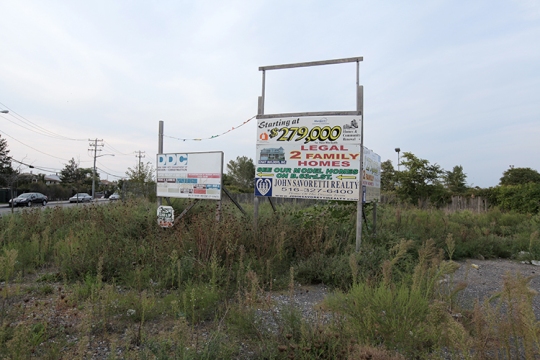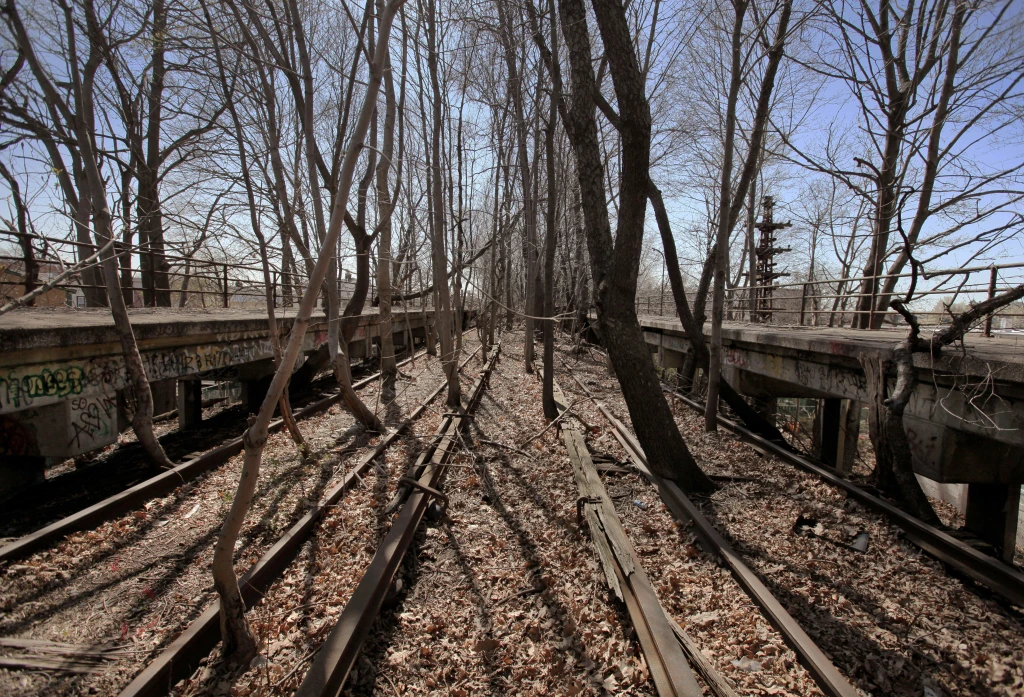AbandonedNYC
queens
Ruins of the ’64 New York World’s Fair

The empty observation towers of the New York Pavilion hover over Flushing Meadows-Corona Park.
In Flushing Meadows-Corona Park, the oddball ruins of the “Tent of Tomorrow” are fading into yesterday. This land had been home to the Corona Ash Dumps—immortalized as the “valley of ashes” in the Great Gatsby—until master builder Robert Moses set out to transform the area by selecting it as the site of the 1939 New York World’s Fair. While the overall design of the park was laid out for the ’39 event, its most evident landmarks date back to the ’64 exhibition. The Space Age design of the New York Pavilion was intended to inspire visitors with the promise of the future, but today it serves to firmly plant the structure in the context of the 1960s.

The New York State Pavilion in its youth.

The tallest tower was the highest point in the fair at 226 feet.
Concieved by New York businessmen and funded by private financing, the 1964-65 New York World’s Fair was once again headed by Robert Moses, who saw the project as an opportunity to complete his vision for Flushing Meadows Park. In order to make the fair financially feasible, organizers charged rent to exhibitors and ran the attraction for two years, ignoring the regulations of the worldwide authority on world’s fairs (the Bureau of International Expositions.) As a result, the BIE refused to sanction the fair and instructed its forty member nations not to participate, which included Canada, most European Nations, Australia, and the Soviet Union.

Faint remnants of bright yellow paint can still be spotted on the metal components of the structure.
The fair was dedicated to “Man’s Achievement on a Shrinking Globe in an Expanding Universe,” but the majority of exhibitors were American companies. Some of the most popular destinations included General Motors’ “Futurama” exhibit, Disney’s original “It’s A Small World” attraction, and a model panorama of New York City (which you can still visit at the Queens Museum of Art). Although over 51 million people attended the fair, the turnout was far less than expected. The project ended in financial failure, returning only 20 cents on the dollar to bond investors.
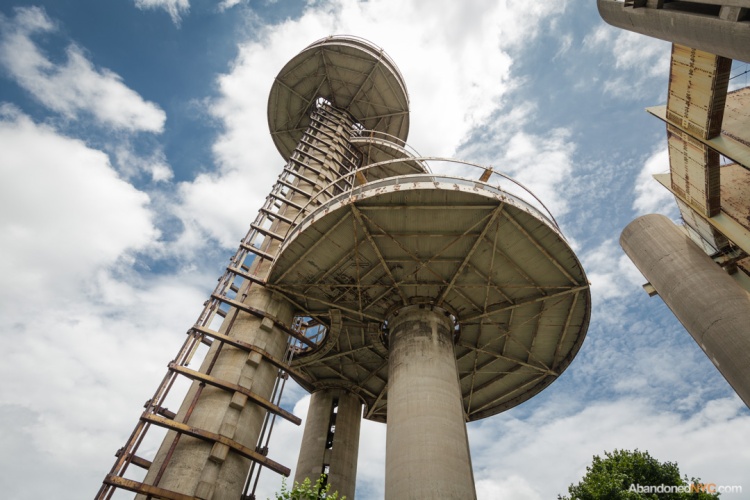
The observation decks were re-imagined as space ships in the original Men In Black film.
Most of the World’s Fair pavilions were temporary constructions that were demolished within six months of closing, but a few were deemed worthy of becoming permanent fixtures of the park. Once the centerpiece of the fair, the 12-story high stainless steel Unisphere has gone on to become a widely recognized symbol of Queens. Designed by notable modernist architect Philip Johnson, the nearby observation towers and the “Tent of Tomorrow” remain striking examples of the Space Age architecture the fair embraced. Unfortunately, they’ve sat empty for decades, and are starting to show their age. In the Tent of Tomorrow, space that once hosted live concerts and exciting demonstrations are occupied by stray cats and unsettling numbers of raccoons.

The Tent of Tomorrow once held the record as the largest cable suspension roof in the world.
The pavilion was reopened as the “Roller Round Skating Rink” in 1970, but roof tiles soon became unstable and the city ordered the attraction to close by 1974. Owing to their singular design, the structures have found their way into the background of many feature films, television shows, and music videos, including a memorable turn as a location and plot element for the original Men in Black. You can still make out the design of the pavilion’s main floor—modeled after a New York state highway map—in this late ’80s They Might Be Giants video.
The New York State Pavilion was listed on the National Register of Historic Places in 2009, and a group of preservationists have helped clean up the exterior, restoring a bit of the original color scheme. As we near the 50th anniversary of the ’64 World’s Fair, here’s hoping something can be done to put these unique structures back to use.
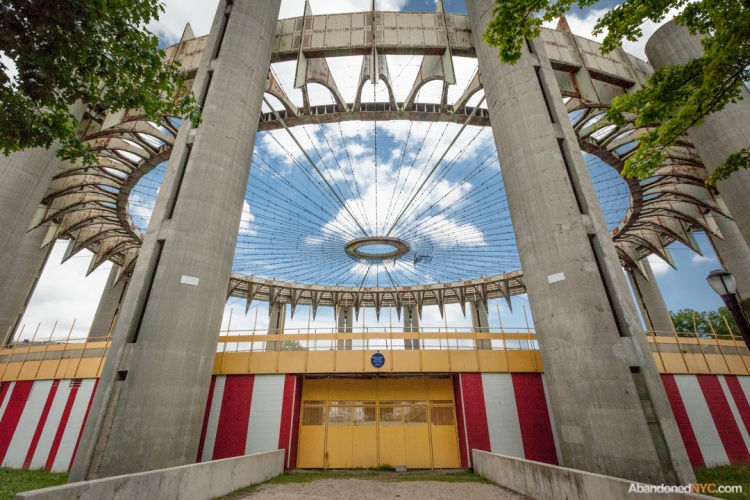
A group of preservationists have restored the original paint job on the structure’s exterior.
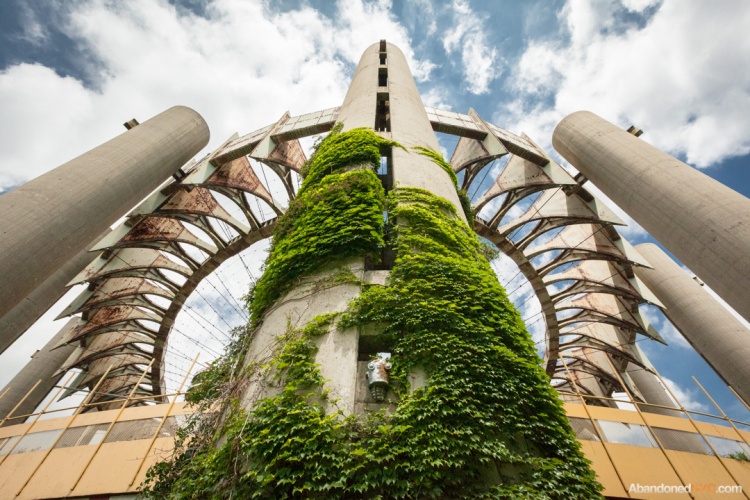
Vines, and a not entirely incongruous robot head, have been affixed to this tower.
A Baseball Graveyard in Queens

An overgrown overpass at Union Turnpike and Woodhaven Boulevard, part of the proposed Queensway project.
Abandoned for half a century, the old Rockaway Beach Branch of the Long Island Railroad is stirring debate today as opposing visions for its future emerge. Before it’s reactivated to serve beleaguered Queens commuters, or converted to the Queensway, (a linear park similar to Manhattan’s High Line), the track remains a 3.5 mile wilderness, with more than a few secrets scattered among the ruins.
At the northern edge of Forest Park, the rails terminate in a parking lot, where antiquated electrical towers have been adapted as streetlights. Across the Union Turnpike, there’s a plot of land that may be the most obscure section of the Rockaway Branch, a triangular junction wedged between a dilapidated warehouse and a complex of baseball diamonds. A well-trod path leading into the place quickly dissolves into a tangle of branches; the plant life is especially lush here, and difficult to navigate.

…just a few paces from a chain link fence that separates a packed field of cheering little leaguers.
Standing in the shadows just beyond the diamond’s edge, you’re practically invisible, in a world between worlds, and right at your feet, dozens of baseballs bloom from the earth like mushrooms…
This is the place the balls go where you can’t get them back, each a martyr and a monument to a home run that may have taken place decades ago or just this morning. Stripped of their leather casing, the older specimens reveal a second skin of frayed cotton yarn. The most ancient are unrecognizable, corrupted to a truffle-like core of black, scabrous rubber. Together, they linger in a bizarre kind of afterlife, populating the century-old tracks of a forgotten railroad—when a place is left alone, the past piles up.
Check out the gallery below for an education in baseball construction, and decay…
-Will Ellis
Talking Trash in Dubos Point Wildlife Sanctuary
Take the A train past JFK. You’ll be one of a handful of travelers left on a car that seemed well over capacity a moment ago; the babble of the crowd fades to the soft hum of an unimpeded machine. Nobody asks you for money, or directions. If you’ve made it this far, you know where you’re going.
Suddenly, the ground drops out and you’re gliding over the silver Jamaica Bay. The train runs just above sea level, skimming over a surface that teems visibly with diving cormorants. Clustered with skeletal boat frames, aged marinas jut from a neglected shoreline across the water, to the west, a row of painted houses stand on stilts. There’s no place like the Rockaways to experience New York as a city by the sea.
Head east at Hammels Wye, and a brief walk through the quiet neighborhood of Averne will lead you to a little known peninsula called Dubos Point, one of the last fragments of salt marsh left in a city that was once ringed with tidal wetlands. The marsh was filled with dredged materials in 1912 in preparation for an ill-fated real estate development, but over the last century, the area has reverted to its natural state. In 1988, the land was acquired by the Parks Department, deemed a wildlife sanctuary, and given an official name for the first time (Rene Dubos was a microbiologist and environmental activist who coined the phrase “Think Globally, Act Locally”).
Parks officials envisioned marked nature trails and boardwalks for community use, and planned to build nesting structures and employ part-time patrol staff to encourage wildlife and keep the place clean, but none of this came to be. The Audubon Society of New York maintained the grounds sporadically until 1999, but abandoned its post citing a lack of resources. Since then, the area has been largely neglected, leaving its care up to volunteers. Green Apple Corps and the Rockaway Waterfront Alliance have orchestrated several clean-up events over the years, but they’re facing an uphill battle.
Every day, the shores of Dubos Point are bombarded with an onslaught of garbage, and it’s not coming from park visitors (the preserve is technically not open to the public). Most of the refuse is washed up from the bay, after a long journey through storm drains that began in the littered streets of New York City. Familiar objects are made strange, touched by a long encounter with an invisible world, caked with green algae, eroded with salt, barnacle-burdened and bleached by the sun. The entire peninsula resounds with the constant susurration of wind through grass. For all these reeds are hiding, perhaps they whisper secrets; mud-moored vessels, decaying toys, and saltbored furniture lay half-concealed in the tidal growth.
Standing water in old tires and plastic debris makes for a perfect breeding ground for the area’s most populous species. My first steps onto the grounds of Dubos Point seemed to disturb some ancient curse, as great swarms of mosquitoes rose from their stagnant hollows to draw my blood sacrifice. The Parks department has been criticized in the past for neglecting its duties at Dubos Point while mosquito infestation reached “plague proportions” in the late 90s, rendering backyards unusable from April to October. After years of complaints and little improvement, some residents resorted to building outdoor shelters for brown bats, a natural insect predator. Today, the only visible improvement made on the grounds of Dubos Point is a line of Mosquito Magnet kiosks, placed every 100 feet along the boundary of the preserve.
Despite decades of pollution, the Jamaica Bay harbors hundreds of species of wildlife, and the water is cleaner today than it was 100 years ago. As one of the last remaining pockets of undeveloped land in New York, the estuary supplies an essential resting place for migratory birds along the Atlantic Flyway; egrets, herons, and peregrine falcons are spotted here. Looking past the garbage, you can still make out the natural beauty of Dubos Point, and imagine what this whole region was like 400 years ago. Neck-high cordgrass is abundant, trapping bits of decayed organisms to fuel a thriving, though limited, ecosystem. Throngs of fiddler crabs crowd the soggy ground, scuttling sideways with one collective mind, crunching underfoot like eggshells. The breezy silence is only interrupted by an occasional splash from a jumping fish, or the roar of a plane, taking off from the crowded runways of JFK just across the water. Off the curling tip of Dubos Point, fishermen still cast their lines in the Sommerville Basin, affirming a bond we’ve all but lost.
12,000 of the original 16,000 acres of wetlands around the Jamaica Bay have already been filled in for development, and sources predict that the last of the saltwater marshes could disappear in the next 20 years. It’s a shame to see one of the few protected areas in this condition, when its potential for education and recreation is so apparent. New York needs to protect its wild spaces, and sometimes that means getting our hands dirty. To learn about volunteer opportunities with the Parks Department, visit their website. And check back for information on the next Dubos Point clean-up.
Inside Fort Totten: Part 1
Fort Totten sits on a far-flung peninsula of the Long Island Sound, forming the Northeast corner of Queens. The grounds of this defunct military installation turned underfunded public park are home to over 100 historic buildings representing a series of changes that have taken place over the area’s quiet 200 year history. Unfortunately, the majority of these stuctures have been disused for decades, and many are in a state of progressive collapse. With so much of Fort Totten closed off with caution tape, overtaken with vines, or hidden beneath rusty fences, it makes for an unconventional park, but a fascinating place to wander.
An 1829 farmhouse predating the land’s military use crumbles behind a weedy barricade; out front, a prominent sign bears the inscription: “Please Excuse My Appearance, I am a Candidate for Historical Preservation.” It’s an image that typifies the current state of affairs in the Fort Totten Historic District.
On the northern tip of Willet’s Point, a monumental granite fortification constructed during the Civil War as a key component of the defense of the New York Harbor sits unoccupied, though it’s used as a haunted house on occasion. Clustered on the rest of the grounds, dozens of dilapidated Romanesque Revival and Queen Anne Style officers’ quarters, hospitals, bakeries, movie theatres, and laboratories vie for restoration, but so far the funding has failed to materialize.
One such building, a two-story YMCA facility built in 1926, has been abandoned for close to 20 years, but much of what’s left behind lies undisturbed. On a bulletin board in an upstairs landing, a 1995 thank-you letter from a kindergarten class at PS 201 hangs by a crude depiction of Santa Claus, both lovingly dedicated to an Officer Rivera. Steps away, in a rotting book room, an incongruous stash of 80s porno magazines.
Most recently used as a community relations unit of the New York City Police Department, the building is cluttered with mattresses, discarded packaging, and unopened toy donations. The New York City Fire Department, which now operates training facilities in a renovation abutting the hospital building, currently uses the attached gymnasium as a storage space. The basement was filled with rusted-through shelving and ruined equipment, flooded and too dark to shoot.

An overgrown pit in a World War I battery.
On the other side of the peninsula, a series of concrete batteries sit half-submerged in plant life. These were constructed at the turn of the century, but by 1938, they were declared obsolete and subsequently abandoned. The boxy design looks like modern architecture to me, but the battery reveals its true age in other ways.
Pencil-thin stalactites ornament the ceiling wherever the rain gets in, suspended over a crank-operated machine designed to lift heavy weaponry a century ago. The network of maze-like tunnels feature arched hallways with metal doors, winding staircases, and yawning pits, all fit for a dungeon. Guards stationed at the fort were laid off in 2009, and it was unclear on my visit if the area was open to the public or not. A rusty barrier, more hole than fence, didn’t keep out a couple of high school kids, but offered a spot for them to park their bikes.
When the military base changed hands in 2005 and became an official New York City Park, Bloomberg predicted that Fort Totten was “certain to become one of New York’s most popular parks.” Some community members feared that the estimated 450,000 yearly visitors would disrupt parking, increase crime, and change the face of the neighborhood, but ten years later, tourism has yet to pose a problem.
Fort Totten hasn’t lived up to its potential just yet, but the progress that has been made gives hope for improvements to come. The park now offers regular events and educational programs to draw visitors and enrich the surrounding community. Several nonprofit groups have occupied and renovated the decrepit buildings, including the landmarked Officers’ Club, which now serves the Bayside Historical Society as an educational facility and exhibition and event space. These are small but significant victories in the effort to save the historic legacy of a little-known plot that could be the crown jewel of Queens parkland.
(Though in some cases, it may be too little, too late. One look inside the profoundly decayed Fort Totten Army Hospital, in Part 2 of this post, will assure you of that.)
-Will Ellis
Related Links:
- Fort Totten Historic District Designation Report
- Fort Totten History from the Bayside Historical Society
- NYTimes 1999 “Fort Totten’s Old Houses are Tottering”
- NYTimes 2003 “Nearer to a Fort Totten Park but Not to a Consensus”
- Scouting NY—A Snowy Day at Fort Totten

This room must have provided temporary housing to minors. The floor was littered with clothing and old English projects.

In the opposite corner, a derelict dollhouse. If I had been in the Twilight Zone, I’d have found a miniature me in there.

Some rooms held a few remnants…
Houdini’s Grave, in NYC’s Spookiest Cemetery

Are we in Queens or Salem’s Lot?
If you pass by a graveyard on the Jackie Robinson Parkway, don’t hold your breath. You’ve got two and half miles of Queens’ Cemetery Belt ahead of you, a burial ground so vast it’s supposedly visible from space. Surrounded on all sides by an ocean of headstones, the modest Machpelah Cemetery makes up only a small fraction of the sprawling necropolis, but its arguably the creepiest graveyard in the city…
Cramped centenarian tombstones muster in rows on the hilly plot—the place is rundown and deserted, but one grave is consistently well-maintained. It’s the monument of Machpelah’s most famous resident, master escape artist Harry Houdini. Only steps from the headstone lurks an eerie cemetery office, abandoned since the late 80s. The cemetery is a dream destination for graveyard ghouls on a chilly October night, especially since Halloween marks the anniversary of Houdini’s untimely death.
The history of the Cemetery Belt can be traced back to the Rural Cemeteries Act of 1847, under which cemeteries became a legitimate commercial enterprise for the first time in New York. Non-profit organizations were authorized to buy up land and sell plots to individuals, replacing the traditional practice of burying the deceased in churchyards and private property.
Areas of then-rural Queens quickly became concentrated with new cemetery holdings. A stipulation of the act limited the acreage of land an organization could purchase in a given county, but church groups and land speculators got around this by buying up neighboring plots on the Brooklyn-Queens border, forming the region now known as the Cemetery Belt.
Between 1832 and 1849, a series of cholera outbreaks thoroughly exhausted Manhattan’s remaining burial sites. The common belief at the time was that ground water could become contaminated with the disease when infected corpses were exposed to the soil. As a result, all burials were prohibited on the island of Manhattan in 1852.
As the population swelled, new developments, including the Brooklyn Bridge, often required the displacement of grave sites. Manhattan started evicting its dead people, and sending them to western Queens—tens of thousands of deceased were disinterred and transported to mass graves in the Cemetery Belt. These ghoulish dealings were kept away from the public eye, often carried out in the dead of night.
Today, Queens’ five million “permanent residents” almost triple its living population, but their numbers are at a standstill. Most of these cemeteries reached capacity long ago, leaving many without a source of income. As a result, some have fallen into disrepair, with officials failing to provide the “perpetual care” their patrons are rightfully owed.
At the nearby Bayside Cemetery, conditions were downright shameful, and hair-raising—exposed human remains were identified at several of the overgrown grave sites. Community pressure, litigation, and the effort of volunteers have gotten the place cleaned up, albeit in a cursory fashion. Gaping mausoleums have been closed off with cinderblocks and boards.
At Machpelah, the plots are untidy, but not nearly as egregious as the Bayside grounds. The cemetery’s decline is most apparent in its ramshackle office building. The boarded-up structure is dilapidated now, but its architecture, dating to 1928, continues to impress on the surface.

Burial records litter the floor of the Machpelah Cemetery office.
Any semblance of grandeur breaks down on the inside. The striking arched windows visible in the facade are installed in rectangular frames, and their diamond panes are all artifice. The skeleton of a drop ceiling hangs askew, with most panels collapsed and reduced to a yellow paste that covers the ground. The office has apparently fallen victim to vandals over the years, furniture and safe deposit boxes have been ransacked, old burial records lie scattered in the grime. Anything of value has been removed, but a coin bank souvenir from the 1939 New York World’s Fair remains, its most recent deposits dating back to 1988.
“Stuffy” doesn’t begin to describe its suffocating ether. Reception rooms are boxed in with cheap wood paneling, which combines with the dizzying funk of mildew to evoke the interior of a coffin. Secluded in a cockeyed armoire, Nosferatu could feel right at home here.

Red roses wilt on Houdini’s grave.
Every Halloween, hundreds of devotees make the yearly pilgrimage to Houdini’s final resting place to pay their respects, party, and make an offering—around the anniversary of his death, pumpkins, broomsticks, and playing cards mount like a cairn on his headstone.
The Society of American Magicians, for which Houdini served as president until his death, was the official caretaker of the site until recently. Between 1975 and 1993, the bust that adorns the Houdini monument was stolen or destroyed four times—it’s thought to be the only graven image in any Jewish Cemetery.
For many years, the likeness was only brought out for yearly ceremonies, but in 2011, a group of magicians from the Scranton Houdini Museum engaged in some guerrilla restoration, installing a new bust with the blessing of Houdini’s family. The group has since taken over responsibilities for the site’s care, and so far the monument remains unscathed.
With no funds to reoccupy, renovate, or demolish the old office building, its likely to stand until it falls down on its own; the same can’t be said of Houdini’s shiny new effigy. Odds are he’ll lose his head again—even though it’s screwed on. So next time you’re traveling down that graveyard highway, be sure to stop by for a look while you can. There’s no need to wait for the witching hour. At Machpelah Cemetery, the gate is always open, and every day is Halloween.
UPDATE: The office was demolished on August 21st, 2013.
-Will Ellis

The lobby, with a distinctive arched doorway, bathed in golden morning light.

The second floor.

Valuable copper pipes were removed from the upstairs.

Several rooms feature vintage wallpaper, but wood paneling had been removed.

Sunlight illuminates a stairwell.

A forbidding basement. The structure could only be accessed through a narrow opening that led to this room.

No vacancy.

Dawn breaks on Houdini’s grave.
Inside Creedmoor State Hospital’s Building 25

The first glimpse of Building 25’s fourth floor from the central stairwell. That’s not gravel.
In Queens Village, mere inches of brick and mortar separate the world we know from one of the strangest places in the city. Once a haven for New York’s cast-out mentally ill, Creedmoor Psychiatric Center’s Building 25 has undergone something of a transformation over its 40 years of neglect.
Creedmoor was founded in 1912 as the Farm Colony of Brooklyn State Hospital, one of hundreds of similar psychiatric wards established at the turn of the century to house and rehabilitate those who were ill equipped to function on their own. Rejected by mainstream society, hundreds of thousands of mentally disturbed individuals, many afflicted with psychosis and schizophrenia, were transferred from urban centers across the country to outlying pastoral areas where fresh air, closeness to nature, and the healing power of work was thought to be their best bet for rehabilitation.
As the 20th century progressed, asylums across the country became overrun with patients, and many institutions became desperately understaffed and dangerously underfunded. Living conditions at some psychiatric wards grew dire—patient abuse and neglect was not uncommon. Creedmoor State Hospital was habitually under scrutiny during this period, beginning in the 1940s with an outbreak of dysentery that resulted from unsanitary living conditions in the wards.
The hospital had spiraled completely out of control by 1974 when the state ordered an inquiry into an outbreak of crime on the Creedmoor campus. Within 20 months, three rapes were reported, 22 assaults, 52 fires, 130 burglaries, six instances of suicide, a shooting, a riot, and an attempted murder, prompting an investigation into all downstate mental hospitals. As late as 1984, the violent ward of Creedmoor Psychiatric Center was rocked with scandal following the death of a patient, who had been struck in the throat by a staff member while restrained in a straitjacket.
In the late 20th Century, the development of antipsychotic medications and new standards of treatment for the mentally ill accelerated a trend toward deinstitutionalization. A series of dramatic budget cuts and dwindling patient populations led to the closing of farm colonies across the United States, and a marked decline at Creedmoor. The campus continues to operate today, housing only a few hundred patients and providing outpatient services, leaving its turbulent past behind. Many of the buildings have been sold off to new tenants. Others, like Building 25, lie fallow.
The building was an active ward until some time in the 1970s, and retains many mementos from its days as a residence and treatment center for the mentally ill. With peeling paint, dusty furniture, and dark corridors, the lower floors are typical of a long-abandoned hospital, but upstairs, the effect of time has taken a grotesque turn.
The smell alone is enough to drive anyone to the verge of madness, but the visual is even more appalling. For 40 years, generations of pigeons have defecated on the fourth floor of Building 25, far removed from their dim-witted dealings with the human world, assembling a monument all their own. Guano accumulates in grey mounds under popular roosts, with the tallest columns reaching several feet in height. Like the myriad formations of a cavern, Buiding 25’s guano stalagmites are a work in progress—pigeons roost at every turn, and they’re awfully dubious of outsiders. Violent outbursts of flight punctuate an otherworldly soundscape of low, rumbling coos. The filth acts as an acoustic insulator, making every movement impossibly close.

These dropping formations formed under the pipes of a sprinkler system the birds frequented. (Prints Available)
Two levels down and a world away from the top floor, a kitchen is filled with years’ worth of garbage intersected by narrow pathways. A living room, kept relatively tidy, features a sitting area with an array of chairs, including a homemade toilet. Loosely organized objects litter every surface—toiletries, clothing, hundreds of dead D batteries. Some of the belongings looked as if they hadn’t been touched for decades, but a newspaper dated to only a few weeks before confirmed my suspicion that someone was still living here.
I found him snoozing peacefully in a light-filled dayroom, surrounded by a series of patient murals. Once painted over, images of faraway lands, country gardens, and the Holy Mother are coming to light again as time peels back the layers. The image was surprising, unforgettably human, and imprudent to photograph. Declining to introduce myself, I passed once more through the dark, decaying halls of Building 25, leaving its charms, horrors, and mysteries for the birds. Back on solid ground, its impression wouldn’t fade for months—Building 25 has a way of recurring in dreams…

Furniture stacked in a cafeteria on Building 25’s third floor.

These chairs are popular with urban explorers, one went as far as covering the upholstery with fake blood.

Metallic sheets are bolted to this bathroom wall in lieu of mirrors, which patients could use as a weapon.

A tiny toy collection arranged on a windowsill. (Prints Available)

An uninviting hallway on Creedmoor’s fourth floor.

This bathroom held the largest volume of fecal matter. (Prints Available)

An incongruous Virgin emerges from an infested day room. (Prints Available)
The Rockaway Beach Branch, Queens’ Forgotten Railroad
New York City’s narrowest jungle stretches across 3.5 miles of Central Queens, concealing the ruins of a rail line that’s been gathering rust for half a century. Abandoned by a bankrupt Long Island Railroad in 1962, the Rockaway Beach Branch is stirring debate today as opposing visions for its future emerge.
A passenger traveling on the Rockaway Beach Branch in the 1920s would board a southbound train at Whitepot Junction, pass through developing neighborhoods in Forest Hills, Glendale, Woodhaven, Richmond Hill, and Ozone Park, and traverse a burgeoning estuarine habitat called Jamaica Bay before arriving in the sandy Rockaways, then a popular vacation destination for privileged Manhattanites known as “New York’s Playground.” Today, the neighborhoods are flourishing, Jamaica Bay is losing 40 acres of marshland a year, and the isolated Rockaways are entering a stage of redevelopment.
The right-of-way was purchased by the city in the 1950s with plans to incorporate the entire line into its subway system, but the NYC Transit Authority ended up linking only the southern portion to the A train, cutting off the 3.5 mile stretch north of Rockaway Blvd. Through its 50 years of disuse, the remaining Rockaway Beach Branch has heard a stream of failed reuse and reactivation proposals as a forest has matured within its borders.
In 2005, community boards from Rego Park, Forest Hills, and other areas intersected by the line passed resolutions in favor of a linear park conversion, encouraged by the success of Manhattan’s High Line—a once abandoned rail line in Chelsea renovated into a futuristic above-ground park. According to the plan, bicycle paths and walkways would replace the derelict railroad, providing a much-needed green recreational space for the public. The Trust for Public Land is seeking private funding for a feasability study as a first step toward making the park, dubbed the “Queensway,” a reality. Beleaguered Rockaway commuters instead call for a reactivation of the line, which would provide a speedy link to Midtown Manhattan and a welcome alternative to the circuitous A-train. In response to this proposal, the MTA cites high operational and construction costs as deterrents to the project.
 Trudging through this palsied limb of the New York City transit system, it’s hard to imagine either plan coming to fruition here, a place where few people venture and fewer have a good reason to. Detritus from teenage excursions and midnight meetings collect in piles along the forgotten spur—scrapped car parts, a coil of barbed wire, scores of bottles, a forsaken shopping cart, and most memorably, a discarded cleaver.
Trudging through this palsied limb of the New York City transit system, it’s hard to imagine either plan coming to fruition here, a place where few people venture and fewer have a good reason to. Detritus from teenage excursions and midnight meetings collect in piles along the forgotten spur—scrapped car parts, a coil of barbed wire, scores of bottles, a forsaken shopping cart, and most memorably, a discarded cleaver.
In a different season, the century-old rails would be obscured by vegetation, but they’re clearly visible on this brisk February afternoon. Forty-year-old birch and oak reclaim the soil, shoving aside iron rails assembled in the 1910s. Fallen branches and debris intersect a continuous line of tracks; most electrical towers still stand, others lay mired in the overgrowth. Leaves crunching under my feet alert a chain of backyard sentinels to my presence. Aside from the dogs and the postman, little else stirs in this quiet residential community; change is coming to the Rockaway Beach Branch—but it could take another 50 years to arrive.




A jagged weapon discarded on an overpass.

A nearby substation abandoned by the LIRR.
